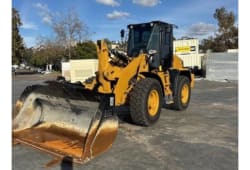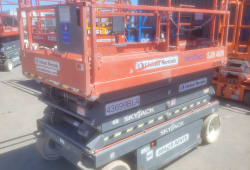The Dynamic World of Heavy Lift Companies: A Closer Look
8 Lectura mínima
)
junio 11, 2023
Heavy lift companies are specialized in the movement of large and heavy objects. They use a variety of equipment, including cranes, barges, and helicopters, to move objects that are too large or too heavy to be moved by traditional methods.
They are used in a wide variety of industries, including construction, oil and gas, and manufacturing. They are often involved in projects that need the movement of large and heavy objects, such as power plants, bridges, and ships.
In the following sections, we will take a closer look at the top-heavy lift companies in the world, the different types of heavy lift equipment, and the challenges of heavy lifting.
The Top Heavy Lift Companies in the World
Mammoet is a Dutch company that is the largest heavy lift company in the world. Mammoet has a fleet of over 700 cranes and other heavy lift equipment, and it has completed projects in over 50 countries.
Sarens is a Belgian company that is the second largest heavy lift company in the world. Sarens has a fleet of over 600 cranes and other heavy lift equipment, and it has completed projects in over 100 countries.
Lampson International is an American company that is a leading provider of heavy lift and transportation services. Lampson has a fleet of over 200 cranes and other heavy lift equipment, and it has completed projects in over 30 countries.
Manitowoc Cranes is an American company that is a leading manufacturer of cranes and other heavy lift equipment. Manitowoc has a fleet of over 100 cranes and other heavy lift equipment, and it has completed projects in over 70 countries.
Liebherr is a German company that is a leading manufacturer of cranes and other heavy lift equipment. Liebherr has a fleet of over 50 cranes and other heavy lift equipment, and it has completed projects in over 100 countries.
Tadano is a Japanese company that is a leading manufacturer of cranes and other heavy lift equipment. Tadano has a fleet of over 30 cranes and other heavy lift equipment, and it has completed projects in over 80 countries.
Grove is an American company that is a leading manufacturer of cranes and other heavy lift equipment. Grove has a fleet of over 20 cranes and other heavy lift equipment, and it has completed projects in over 60 countries.
Kobelco is a Japanese company that is a leading manufacturer of cranes and other heavy lift equipment. Kobelco has a fleet of over 10 cranes and other heavy lift equipment, and it has completed projects in over 50 countries.
Zoomlion is a Chinese company that is a leading manufacturer of cranes and other heavy lift equipment. Zoomlion has a fleet of over 50 cranes and other heavy lift equipment, and it has completed projects in over 40 countries.
These companies are all leaders in the heavy lift industry, and they have the expertise and equipment to handle even the most challenging projects. They are used in a wide variety of industries, including construction, oil and gas, and manufacturing. They are often involved in projects that need the movement of large and heavy objects, such as power plants, bridges, and ships.
The Different Types of Heavy Lift Equipment
There are many different types of heavy lift equipment, each with its own advantages and disadvantages. Some of the most common types of heavy lift equipment include:
Crawler cranes are mobile cranes that are mounted on tracks. They are very versatile and can be used in a variety of applications, but they can be slow to move and set up.
Tower cranes are fixed cranes that are mounted on a tower. They are very tall and can lift very heavy objects, but they are limited in their mobility. Mobile cranes
Mobile cranes are cranes that can be moved from one location to another. They are not as versatile as crawler cranes, but they are faster to move and set up. Helicopter cranes
Ship cranes are cranes that are mounted on ships. They are used to load and unload cargo from ships.
Helicopter cranes are helicopters that have been modified to lift heavy objects. They are very versatile and can be used in a variety of applications, but they can be expensive to operate.
Airships are airships that have been modified to lift heavy objects. They are very slow and can only lift light objects, but they are very cost-effective and can stay in the air for long periods of time.
Lifting balloons are balloons that have been modified to lift heavy objects. They are very slow and can only lift light objects, but they are very cost-effective.
The choice of heavy lift equipment depends on the specific application. For example, a crawler crane would be a good choice for a project that requires a large crane that can be moved over rough terrain, while a tower crane would be a good choice for a project that requires a tall crane that can lift very heavy objects.
The Challenges of Heavy Lifting
Heavy lifting is a complex and challenging process. They are very important because they allow for the safe and efficient movement of large and heavy objects. They have the expertise and equipment to handle even the most challenging projects. There are many factors that can make heavy lifting difficult, including:
Weight: The weight of the object being lifted is the most obvious challenge. The heavier the object, the more force is required to lift it.
Size: The size of the object being lifted can also be a challenge. Large objects can be difficult to maneuver and can need special equipment to lift.
Distance: The distance that the object must be lifted can also be a challenge. The longer the distance, the more time and energy required to lift the object.
Weather: The weather can also be a challenge for heavy lifting. Strong winds can make it difficult to control the object being lifted, and rain or snow can make the ground slippery and dangerous.
Safety: Safety is always the top priority when lifting heavy objects. There are many potential hazards associated with heavy lifting, including falls, crushing injuries, and electrical hazards. It is important to take all necessary safety precautions when lifting heavy objects.
Despite the challenges, heavy lifting is a necessary part of many construction and industrial projects. By planning and executing heavy lifting operations, it is possible to lift even the heaviest objects.
The Future of Heavy Lift Companies
The future of heavy lift companies is bright. The demand for heavy lifting services is expected to grow in the coming years, due to the increasing complexity of construction projects and the need to move large objects over long distances. This growth will create opportunities for heavy-lift companies to develop new technologies and improve their services.
Some of the key trends that will shape the future of heavy lift companies include:
The rise of automation: Automation is already being used in some heavy lift operations, and this trend is expected to continue in the future. Automated systems can help to improve safety, efficiency, and productivity.
The development of new technologies: New technologies, such as 3D printing and robotics, are being developed that could revolutionize the heavy lift industry. These technologies could make it possible to create lighter and stronger structures and to move objects more easily and efficiently.
The increasing demand for heavy lifting services: The demand for heavy lifting services is expected to grow in the coming years, due to the increasing complexity of construction projects and the need to move large objects over long distances. This growth will create opportunities for heavy-lift companies to expand their operations and enter new markets.
Heavy lift companies that are able to adapt to these trends will be well-positioned for success in the future. By investing in new technologies and developing innovative solutions. The heavy-lift companies can help to meet the growing demand for their services and build a strong future for their businesses.
Conclusion
Heavy lift companies play an important role in the global economy. They are responsible for moving large and heavy objects, such as power plants, bridges, and ships. The industry faces a number of challenges, including the weight and size of the objects they must move. The distance they must travel, and the weather. However, the industry also has a number of opportunities. including the rise of automation, and the development of new technologies.
They can include the increasing demand for heavy-lifting services as well. By adapting to these challenges and opportunities, heavy-lift companies can build a strong future for their businesses and play a vital role in the global economy.

Caleb Woods is an experienced content specialist and an editor at Boom & Bucket, blending his journalism background with expertise in the heavy equipment industry. He delivers engaging, informative content to help professionals stay informed and make smarter decisions in the machinery market.














